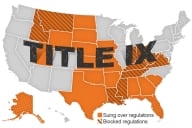You have /5 articles left.
Sign up for a free account or log in.
I know! I know! Everyone is sick to death of debating the pros and cons of MOOCs, the massive online courses that, depending on your viewpoint, will be the downfall or resurrection of higher education. But what's getting lost in all the noise is that MOOCs are far from the only game in town when it comes to online education.
Key in determining the effectiveness of a course, both online and on the ground, is how actively it is being taught and how effectively it is engaging students.
Educators are creating and tweaking a number of very different learning models to engage students in "active learning," both in the physical classroom and the virtual world – often in intriguing combinations.
Based on innumerable conversations with faculty, students, administrators, staff, and the general public, the following are the three most important things I know about the role distance education plays in higher education today and about how to create high-quality programs.
Distance education is not a singular thing.
Educators and administrators often use only the terms "synchronous" and "asynchronous" to differentiate among distance education models. But the most critical descriptor of distance education models has nothing to do with the extent of live instruction; rather, it is the extent to which a course is "actively taught."
On one side of the active-teaching spectrum is a "course-in-a-box" -- a course with pre-built media assets meant to stand alone, with minimal or no involvement or intervention by the faculty. MOOCs, for instance, often consist of pre-recorded high-production video and automated assessments. If the faculty member were to disappear or otherwise disengage from the course, the course would still exist. The thousands of students in the MOOC could simply press the play button on the screen, answer automatically graded test questions and otherwise enter input as appropriate. And, of course, the size of the MOOC is nearly limitless, subject only to technology capacity constraints.
On the other side of this spectrum is the very actively taught class. Independent of media assets available to students, faculty teach. They communicate with students, lead discussion, provide feedback, and otherwise engage. If a faculty member were to stop teaching, the class would cease to exist. Typically, such actively taught courses are smaller and require that faculty know and interact with students much more intimately, more like a seminar than a lecture hall.
Some MOOCs employ teaching assistants, striving for modest interaction with students. However, in most cases, the scale of MOOCs overwhelms even multiple instructors; plus, TAs are, by definition, not faculty. Thus, while MOOCs may be great for personal enrichment, most are not yet appropriate for college credit, given that they are largely unresponsive to the learning needs of any given student.
The questions being asked about effective distance education aren’t all that different from those concerning "traditional" teaching models.
Just as with traditional education, one the greatest challenges of distance education is how to better engage students. Traditional educators often discuss the role of lecture, discussion, feedback, group projects and peer assessment. Today they also talk about "flipping the classroom" so that lectures and other didactic material are recorded and made available to students outside of class. Class time can then be reserved for discussion and application.
Understanding that student engagement is highly correlated to active teaching, distance educators are addressing the very same issues. The "course in a box" model is rarely engaging - many MOOCs create very passive experiences for students, who are required to watch hours of video and answer machine-graded multiple choice questions.
That said, some "course in a box" exceptions come close to rivaling substantive live interactions. Simulations, games, and other online modules in which students must solve problems and make decisions within an automated environment can be very effective teaching tools that adapt to students’ varying levels of skill and mastery. Fully adaptive learning technologies may, in fact, be more engaging than traditional teaching, given that students’ learning experiences may be customized to individual needs.
Of course, not even all traditional education is "active." A professor’s recitation of pre-written 75-minute lectures twice a week for an entire term would hardly be more active than simply recording those lectures and posting them on a website. An actively taught traditional course, like a distance education course, would require the faculty member to engage much more intimately with students through discussion, feedback, and more.
While some asynchronous models have no active teaching element -- including many MOOCs -- others rely on highly active and present faculty to asynchronously engage with students. Asynchronous communications, including group discussion boards, blogs, and wikis, can lead to more substantive exploration of course material than live, in-person conversations. Some faculty report that asynchronous communications allow students to better digest and consider others’ opinions while constructing their own beliefs, and can lead to deeper and more robust discussions.
Putting aside the aforementioned adaptive and interactive learning technologies (which are still relatively rare), an active teacher can better understand the needs of each student and differentiate instruction, customizing discussion and explanations as appropriate. Non-active teaching -- whether through distance or traditional education -- tends to be inflexible and monolithic.
Faculty conversations about distance education are shifting markedly.
Faculty today are less interested in debating the quality of distance education and how much a student can learn. Perhaps the launch of edX by MIT and Harvard opened the gates -- suddenly high-profile, top-notch universities were committing to distance education with significant resources, searching for new ways of teaching and learning.
For whatever reason, today’s conversations by faculty focus less on quality and more on the qualities of distance education. Many express concern that a distance course may be deficient at enhancing cognition, emotion and interpersonal relationship-building, or at developing the "whole student." These are reasonable concerns. No serious distance educator would ever suggest that distance education fully supplants the benefits of a live in-person experience. Rather, we argue that the loss of face-to-face benefits in a classroom can be mitigated in a distance learning environment if students achieve the intended learning outcomes while benefiting from convenience and increased access to higher education.
Faculty are also keenly interested in the impact of distance education on higher education broadly and the faculty workforce specifically. Given that distance courses can be taught by faculty anywhere in the world to students anywhere in the world, they question whether distance education will result in a sort of standardization of curriculum, fewer faculty at their home institutions, and lower standard of quality.
While not unreasonable, such questions must be considered within the context of how distance education is evolving. If today’s MOOCs become widely available for credit, concern would be merited. However, if most credit-bearing distance education is "actively taught," then the risks are lessened, if only because the costs of actively taught distance education can be just as great as the costs of traditional education.
Besides, without dramatic change, institutions of higher education, many of which are in financial distress, face a highly uncertain future. The question to ponder: how a future with distance education compares to all other possible futures for higher education.








